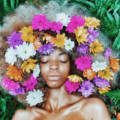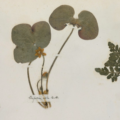Conversations: Tennison S. Black and James Morehead

Tennison S. Black (L) is the author of Survival Strategies (winner of the National Poetry Series, UGA Press 2023). Their work has appeared or is forthcoming in SWWIM, Hotel Amerika, Booth, Wordgathering, and New Mobility, among others. Black received their MFA from Arizona State University and currently serve as the Managing Editor of Sundress Publications as well as Best of the Net. They’re also the editor of the anthology on contemporary disability, A Body You Talk To. Though born in Sonora, Black resides in Washington state.
James Morehead (R) is Poet Laureate of Dublin, California, host of the Viewless Wings Poetry Podcast, and the author of several collections of poetry, including canvas, portraits of red and gray, and The Plague Doctor. James’ poem “tethered” was transformed into an award-winning hand drawn animated short film while his poem “gallery” was set to music for baritone and piano. Other work has appeared in the Ignatian Literary Magazine, Beyond Words Literary Magazine, Citron Review, Prometheus Dreaming, Cathexis Northwest Press, and other publications.
James Morehead: Tennison, in Survival Strategies you have crafted a journey that is unlike many poetry collections, from clearly stating “I hated this desert” to exploring a more nuanced perspective of your Sonoran Desert heritage. How did you approach crafting a book of poetry that has many elements of a novel?
Tennison S. Black: The elements felt disparate for a very long time. Years. From conception (which was just that I wanted to unite my childhood lived experience with my current adult experience of the desert) up through maybe the last year, it didn’t have an arc. So I can’t say I conceptualized it that way or that I was trying to coax anything into an arc. But as I kept reworking the manuscript, the arc started to emerge and eventually I did realize it had story.
Arranging poetry collections is a challenging art form for me. A part of me gets exasperated and wants to throw it all together, let it be whatever it wants to be, let chaos do the work. I’m impatient with my own process, always wanting to have accomplished something rather than staying in the moment of doing. Somewhere in there, despite the impatience, it came together in an arc as I was trying (again) to reorder the whole. It was sudden, the moment I realized it, and when I saw it, it clicked into place.
There’s no premeditated genius that allowed me to have some forethought of how it would all work out—nor really did I have any destination in mind—to write, or to conceptualize, to form existing work into a collection, I just stay in the work, keep my eyes on the work (which is my mantra when I start to look around at other projects or worry that I’m not far enough along in some imaginary trajectory)—”keep your eyes on the work” I tell myself when I get sad that I didn’t get an acceptance at some journal or that I missed out on some award, just ‘stay in the work’ is all I have, really. And let the work find its way.”
James, can you speak to the pairings of image and text? Specifically, while I know you didn’t draw them, I’m wondering if you had a hand in their design at all and if so, what that process was like?
JM: The Plague Doctor actually started its life as a traditional chapbook without images, and a traditional publisher offered a contract to publish the book. Between the time I submitted the chapbook to multiple publishers for consideration, and when I had a deal on the table, my ambitions for the book had expanded. A deciding moment was serendipitous: I was attending SiliCon 2022 in San Jose, CA and stumbled on the booth for an up-and-coming artist, “Eerie Ink” (Natalia Andrus). I was blown away by Natalia’s fine ink art and the seed was planted to incorporate commissioned art into the book, which led to adding my photographer, and additional art and photographs by other artists.
With visual design as important as the poetry, I expanded the length of the book and decided to not only be the book’s author, but also the designer for the book cover, interior, and even an accompanying website with multimedia material that expands the book. The words, images, art, and design are all important elements in The Plague Doctor.
TSB: Can we talk about memory? I think we both did a lot of memory work for these collections. Are you cognizant of your memories as things you carry when you’re writing remembered events/people/places? What does the act of committing your memories to a poem do to the memories themselves?
JM: The process of writing poetry is an extraordinary tool for tapping into memories. To use memories as raw material for a poem, or to use as a turn in a poem that starts about something completely unrelated to a memory, requires reliving a moment. To use that memory means mining every sense that fired—what I saw, heard, felt, smelled, touched—the more I try to capture a memory in words, the more I remember. The Plague Doctor includes multiple poems that are entirely grounded on memory or enhanced by memory.
My second book, portraits of red and gray, was built around a series of 24 poems that captured a trip I took to the Soviet Union in 1983. I wrote that series of poems years after the trip and only had my memories to go on, no notes or journal, no photographs. When I started the poems I started with the strongest memory and gradually tapped deeper into the trip, unlocking memories in the process. It was extraordinary how poetry unearths memories in a way that makes them permanently present.
I encourage poets to capture or incorporate powerful or meaningful memories in poetry, whether as standalone memoir poems or as turns in a poem, you’ll be amazed at the effect that has on your ability to recall your past.
I’m equally interested in how you approached the memories present in your book, especially your experiences and challenges growing up in the Sonoran Desert, memories that were painful in many cases. Did the act of writing those memories down, of crafting poetry from the essence of those memories, provide any sense of comfort or closure?
TSB: In therapy they always want you to journal. So somehow I really believed that writing would heal me. At some level I think I knew poetry would help me heal things I had long needed to heal but that I mostly just tried to ignore. But that’s not what happened at all. I could not have been more wrong.
The memories hurt like hell coming up. There was so much crying I could’ve shorted out my keyboard. Shirt soaking crying. Seriously. And often I would leave it and come back another day or another month or work on some other area. Because at that stage it hurt but also the material it produced was raw and bitter and had no finesse or craft and no balance at all. It was all pure Gen X level f*ck y*u.
One of my dear friends mentioned to me that I might consider pushing out to third person. And I recalled of course that bell hooks pushes out into the third person when things get dicey, so I tried it and that helped a lot. That let me sit for longer because I had a character and everything happened to her. Eventually it came back to first person. But what I’m getting at is that the poetry hurt, it didn’t heal.
But in trying to be fair, in seeking balance, in working through the craft of it, I started to let it soften, let it be embers, not acid. And in there somewhere, as I looked into the desert and started to find the names of things that had scared me—scarred me—I started to name them, to understand them, and I started to find things to love and appreciate. And that’s when I finally started to heal. Or at least I was able to stop picking at it.
So do you generally have ideas for the whole of the book before you start then? Do you know the shape, what’s going in and what’s not for this book as you work? Do you know what topics are going to be included from the start?
JM: My first two books, canvas and portraits of red and gray, were true collections, in that I crafted the books from individual poems (or in the case of “portraits of red and gray” a long series of poems about the Soviet Union trip, and then additional memoir poems). I had to find a way for the poems to be connected in thematic ways. For “canvas” sections served the purpose, and for portraits of red and gray the ordering of the poems without sections worked better.
My latest book The Plague Doctor did start with a unifying idea, inspired by the title poem. Many of my poems up to that point drew deeply from my lived experience, memoir poems or poems anchored on my direct experience. For The Plague Doctor I enjoyed exploring unsettling, creepy imagery, and ekphrastic poetry. I had an emotional arch in mind for the book, with a strong sense of what the first and last poems should be.
When I expanded the book beyond a chapbook in length, I thought of the book in three Acts, Shakespearean in tone, with each act having exactly nine poems. The middle Act also employs an all lower case style that I like to use in some of my poetry, with a visual softening, a relief, before the third Act ratchets up the unsettling imagery.
I’m working on a book now that I hope to finish in a year that is the most project / idea-driven, it’s an ekphrastic tour of San Francisco museums. I’m visiting each museum in San Francisco and writing one or more poems inspired by each museum. Collectively it will be a kind of tour guide with the poetry hopefully inspiring readers to visit each museum – from the Tenderloin Museum to the Legion of Honor and everything in between. And someday I’d like to tackle a novel in verse, inspired by the brilliant work of Safia Elhillo.
In Survival Strategies you employ many different forms of poetry, from a verse-inspired short story to free verse to prose poetry and more structured forms. Is there a particular poetic form that you gravitate towards, and how do you approach which form a poem requires?
TSB: Primarily, though not exclusively, I don’t write in form, I edit in form. There has to be some material on the page for me to really be able to work at all and any forms I produce are built this way. Using memory or idea or prompts—some catalyst, I write into the idea. Often there are line breaks sort of intuited as I go along, so the result looks something like a poem—there are caesura, often some assonance—I love synecdoche so some of those often appear. But then I have a word pile to work with. Then I can really start to create forms and work it into shapes. Sometimes the form evades me and a poem will go into one then another and continue to frustrate me as it never quite feels right. This happened with both “Rodeo Night” and “The Mother and the Mountain” in Survival Strategies.
Sometimes I think I’m actually not a writer at all, but am actually an editor. Very rarely a poem will land exactly how I want it the first time out and change only slightly. There are a few of those in my second collection but almost none in Survival Strategies so maybe it’s that I still have much growth to do as a writer and it’ll start to be more like that as I mature in my practice—but for now I feel that it’s about play and caring, and making room for shape to occur more than creating shape itself.
Given the statement above about maturing, since you have more than one collection and this is my first, can you tell me how the process of accumulation + time + practice has changed your poetry as well as yourself? And in that same vein do you have any advice for a debut poet?
JM: I started my poetic journey without the benefit of formal critique from other poets. I wrote for myself, friends, and family and sporadically when inspiration struck. The biggest thing I’ve learned going into my most recent book is how much critique from other poets can improve your work, and that writing often creates inspiration. I no longer wait for inspiration—I just write (sometimes with no starting point or destination in mind).
The other thing I’ve learned with my most recent book The Plague Doctor is how visual design (photography, art) and collaborations with other artists (painters, musicians, filmmakers) can provide creative sparks.
Finally I’ve learned how important it is to recite poetry in public (and in private) as part of the revisioning and editing process. Poems have two lives: life written form, and life in audio form. For all three of these I sought out feedback loops. A local writing club has a poetry critique group, and I meet with a poetry coach periodically. I seek out collaborations with other artists, and I look for any opportunity to recite my poetry in a public setting.
For the debut poet, welcome to a wonderful community of writers that is excited to explore your work. Poets learn from other poets.





